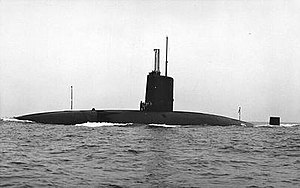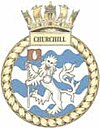HMS Churchill (S46)
 HMS Churchill at sea | |
| History | |
|---|---|
| Name | HMS Churchill |
| Namesake | Winston Churchill |
| Ordered | 21 October 1965 |
| Laid down | 30 June 1967 |
| Launched | 20 December 1968 |
| Commissioned | 15 July 1970 |
| Decommissioned | 28 February 1991 |
| Fate | Awaiting disposal |
| Badge |  |
| General characteristics | |
| Class and type | Churchill-class submarine |
| Displacement | 4,900 tonnes (4,823 long tons) submerged |
| Length | 86.9 m (285 ft 1 in) |
| Beam | 10.1 m (33 ft 2 in) |
| Draught | 8.2 m (26 ft 11 in) |
| Propulsion | 1 Rolls-Royce PWR nuclear reactor, 1 shaft |
| Speed | 28 knots (32 mph; 52 km/h) submerged |
| Complement | 103 |
| Armament |
|
HMS Churchill was the first of three Churchill-class[a] nuclear fleet submarines that served with the Royal Navy.
Construction
In 1965, following a decision by the Labour government not to build a fifth Resolution class ballistic missile submarine, production of nuclear-powered fleet submarines, which had been postponed owing to the priority given to the Polaris programme, could be restarted.[1] Churchill, the Royal Navy's fourth nuclear-powered fleet submarine was ordered on 21 October 1965, and was laid down at Vickers Shipbuilding and Engineering Limited (VSEL)'s Barrow-in-Furness shipyard on 30 June 1967.[3] Following a collision between sister submarine Warspite and a Soviet Echo II-class submarine in the Barents Sea on 9 October 1968, the fin of Churchill, still under construction at Barrow, was used to replace Warspite's fin, which had been badly damaged in the collision.[5][6] Churchill was launched by Mary Soames, Winston Churchill's youngest daughter, on 20 December 1968,[7] and commissioned on 15 July 1970.[3]
Propulsion
Churchill was chosen to trial the first full-size submarine pump jet propulsion. Trials of a high-speed unit were followed by further trials with a low-speed unit, and these were successful enough for the same propulsion to be fitted in the rest of the class.[8] Later British submarine classes also featured the pump jet, although first-of-class vessels Swiftsure and Trafalgar were fitted with propellers at build.
Notes
Citations
- ^ a b Hennessey & Jinks 2016, p. 291.
- ^ Friedman 2021, Chapter 7: Going Nuclear "SSN 04 and SSN 05 were described as the Repeat Valiant Class (NSR 7064)."
- ^ a b c Blackman 1971, p. 336.
- ^ Gardiner & Chumbley 1995, p. 530.
- ^ Ballantyne 2014, p. 134.
- ^ Hennessey & Jinks 2016, pp. 310–313.
- ^ Gingeill, Basil (21 December 1968). "Tradition broken by Navy". The Times. No. 57440. p. 1.
- ^ Bud, Robert; Gummett, Philip (2002). Cold war, hot science: applied research in Britain's defence laboratories, 1945-1990. NMSI Trading Ltd. p. 166. ISBN 978-1-900747-47-9.
References
- Ballantyne, Iain (2014). Hunter Killers: The Dramatic Untold Story of the Royal Navy's Most Secret Service. London: Orion. ISBN 978-1-4091-3901-0.
- Blackman, Raymond V. B., ed. (1971). Jane's Fighting Ships 1971–72. London: Sampson Low, Marston & Co., Ltd. ISBN 0-354-00096-9.
- Friedman, Norman (2021). British Submarines in the Cold War Era. Barnsley, UK: Seaforth Publishing. ISBN 978-1-5267-7123-0.
- Gardiner, Robert; Chumbley, Stephen, eds. (1995). Conway's All the World's Fighting Ships 1947–1995. Annapolis, Maryland, US: Naval Institute Press. ISBN 1-55750-132-7.
- Hennessey, Peter; Jinks, James (2016). The Silent Deep: The Royal Navy Submarine Service since 1945. Penguin. ISBN 978-0-241-95948-0.
